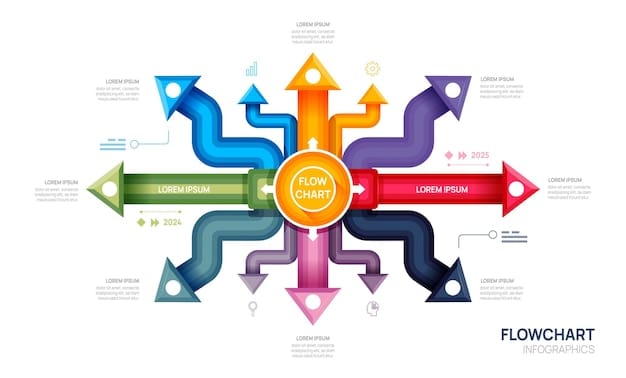Federal Funding Guidelines for Community Action Projects: What’s New by 2025

The New Federal Guidelines for Community Action Project Funding: What You Need to Know by January 2025 introduce significant updates impacting eligibility, reporting, and compliance for organizations seeking federal support, requiring proactive adaptation to secure vital resources for community development.
As we approach January 2025, a crucial deadline looms for organizations dedicated to community action across the United States. Understanding the New Federal Guidelines for Community Action Project Funding: What You Need to Know by January 2025 is not merely an administrative task; it’s essential for the continued success and sustainability of programs that uplift countless lives.
Understanding the Shift in Federal Priorities
The landscape of federal funding for community action projects is constantly evolving, reflecting national priorities and societal needs. The upcoming guidelines by January 2025 represent more than just minor adjustments; they signal a significant shift in how projects are evaluated, funded, and managed. This section will delve into the underlying reasons for these changes and what they broadly aim to achieve.
Historically, federal funding has played a pivotal role in addressing poverty, inequality, and public health concerns at the local level. However, challenges such as accountability, impact measurement, and equitable distribution have always spurred revisions. The current updates are largely driven by a desire for greater transparency, demonstrable outcomes, and a more streamlined application process.
Enhanced Focus on Data-Driven Outcomes
One of the most noticeable aspects of these new guidelines is the increased emphasis on data. Funding decisions will be heavily influenced by an organization’s ability to demonstrate not just activities, but quantifiable outcomes. This means moving beyond reporting how many people were served to showing the tangible impact on their lives and communities.
- Impact Measurement: Projects must clearly define measurable objectives and robust methodologies for tracking progress.
- Data Collection Protocols: Organizations will be expected to utilize standardized data collection tools and processes.
- Reporting Requirements: More detailed and frequent outcome-based reports will likely become mandatory.
This shift requires a proactive approach to data management and evaluation. Organizations that have not traditionally prioritized rigorous data collection will need to invest in new systems and training. The goal is to ensure that federal dollars are being deployed effectively, addressing root causes rather than just symptoms, and fostering sustainable community improvements.
Furthermore, these guidelines seek to address disparities in funding distribution. There’s a concerted effort to ensure that underserved communities and marginalized populations receive equitable access to resources. This involves reviewing existing funding models and potentially introducing mechanisms to support smaller, grassroots organizations that may have historically faced barriers to federal grants.
In essence, the federal government is aiming for a more strategic and impactful allocation of funds. This necessitates a heightened level of planning, execution, and evaluation from all applicants, ensuring that projects align directly with national objectives for community resilience and well-being.
Key Changes in Eligibility Criteria
For many community action organizations, the eligibility criteria are the gateway to federal funding. The upcoming guidelines for January 2025 introduce several critical modifications that could impact who qualifies for support. It’s imperative for all potential applicants to review these changes meticulously to avoid disqualification.
Strengthened Organizational Capacity Requirements
Beyond traditional non-profit status, there will be clearer expectations regarding an organization’s operational capacity. This includes financial management, governance structures, and staff expertise. The aim is to ensure that funded entities possess the stability and capability to manage federal funds responsibly and deliver on their proposed projects.
- Financial Audit Standards: Stricter adherence to generally accepted accounting principles (GAAP) and potentially independent audit requirements for smaller grants.
- Governance Structure: Clear definition of board responsibilities, conflict of interest policies, and diversity in leadership.
- Staff Qualifications: Documentation of key personnel’s experience and expertise relevant to the project’s scope.
These augmented requirements reflect a commitment to fiscal prudence and programmatic excellence. Organizations that can demonstrate a strong, well-managed operational framework will stand a better chance in the competitive funding landscape. This may involve investing in professional development for staff or strengthening internal financial controls.
Another significant change pertains to collaborative efforts. The new guidelines are expected to favor projects that demonstrate robust partnerships with other community organizations, local government agencies, and even private sector entities. This push for collaboration aims to foster more holistic and sustainable solutions to complex community challenges, leveraging diverse resources and expertise.

In some instances, new eligibility criteria may also focus on the geographic scope or demographic reach of projects. Proposals targeting specific underserved regions or populations, or those addressing emerging community health or economic crises, might receive preferential consideration. Understanding these nuanced preferences can significantly enhance an application’s appeal.
Preparing for these shifts means conducting an internal assessment of your organization’s strengths and weaknesses against the proposed criteria. Identifying areas that need improvement and proactively addressing them before the Jan 2025 deadline will be crucial for maintaining eligibility and securing vital funding.
New Application Procedures and Deadlines
Navigating the federal grant application process can be complex, and the new guidelines promise further refinements. Organizations should anticipate updated procedures, potentially new online portals, and certainly new deadlines. Proactive preparation will be key to submitting successful applications.
The federal government is continuously striving to streamline the application process, often transitioning to digital platforms. While this aims to increase efficiency, it also requires applicants to be familiar with new interfaces and submission protocols. Training and familiarization with any new systems well in advance are highly recommended.
Emphasis on Digital Submission Platforms
The trend towards fully digital applications is expected to accelerate. This means more forms, attachments, and supporting documentation will need to be submitted electronically. Reliable internet access and familiarity with digital document management will be essential.
- Mandatory Online Portals: Expect all applications to be submitted through designated federal grant portals.
- Digital Signature Requirements: Electronic signatures may become standard for all official documents.
- Attachment Formats: Strict guidelines on file types, sizes, and naming conventions for all uploaded documents.
Beyond the technical aspects, the content of the application itself will see changes. There will likely be a heightened focus on concise, yet comprehensive, narratives that clearly articulate the project’s goals, methodologies, and anticipated impact. The ability to present complex information clearly and persuasively will be a significant advantage.
Perhaps most critically, organizations must pay close attention to the revised deadlines. These will be firm, and late submissions are rarely, if ever, accepted. Creating an internal timeline that accounts for all necessary steps—from concept development to final review—is paramount to avoiding last-minute rushes and potential errors.
Furthermore, some guidelines might introduce phased application processes, where initial concept papers are reviewed before a full proposal is invited. Understanding these multi-stage processes will allow organizations to allocate resources effectively and tailor their submissions to each stage’s specific requirements. Staying informed through official government publications and webinars will be invaluable.
Reporting and Compliance: A Stricter Landscape
Securing federal funding is only half the battle; robust reporting and strict compliance are equally critical for sustained support. The January 2025 guidelines are expected to introduce a stricter, more detailed framework for how funded projects report their progress and ensure adherence to federal regulations.
The objective behind increased scrutiny is to ensure accountability and to demonstrate the effective use of taxpayer dollars. This means organizations will need to be more meticulous than ever in their record-keeping and transparent in their reporting. Proactive internal audits and compliance checks will become standard practice for high-performing grantees.
Enhanced Financial Transparency and Auditing
Expect more rigorous financial reporting requirements, possibly including new categories for expenditure tracking and more frequent audit schedules. The aim is to prevent fraud, waste, and abuse, ensuring that every dollar is spent efficiently and ethically.
- Itemized Expense Reporting: More granular detail required for all project expenditures.
- Mandatory Single Audits: Organizations receiving substantial federal funds may face more frequent and comprehensive single audits.
- Internal Control Documentation: Grantees must demonstrate robust internal financial controls and policies.
Beyond financial compliance, programmatic reporting will also intensify. As mentioned earlier, the focus on data-driven outcomes will necessitate more sophisticated methods of tracking and reporting project impact. This could involve new performance indicators, standardized data dashboards, or even real-time reporting mechanisms.
Compliance also extends to ethical practices, civil rights considerations, and adherence to environmental regulations, depending on the project’s nature. Organizations will need to attest to their compliance with a broader range of federal statutes and potentially undergo periodic reviews to ensure ongoing adherence. Ignorance of a regulation is rarely an acceptable defense in the event of non-compliance.
These stricter requirements call for dedicated resources to manage reporting and compliance. This might involve hiring dedicated compliance officers, investing in specialized software, or engaging external consultants. The long-term benefits of robust compliance—maintaining funding eligibility and organizational reputation—far outweigh the initial investment.

Leveraging Technology for Greater Efficiency
In an era defined by digital transformation, leveraging technology is no longer a luxury but a necessity for community action projects, especially under the new federal guidelines. Technology can significantly enhance efficiency in compliance, reporting, and overall project management, making organizations more competitive and transparent.
The federal government itself is investing in digital solutions to streamline its grant-making processes. Consequently, organizations that can seamlessly integrate their operations with these digital frameworks will gain a distinct advantage. This includes everything from application submission to ongoing project monitoring and impact assessment.
Adopting Project Management Software
Modern project management tools can centralize tasks, track progress, manage budgets, and facilitate team collaboration. Implementing such software can dramatically improve an organization’s ability to meet deadlines and fulfill complex reporting requirements.
- Grant Management Systems: Specialized platforms for tracking grant applications, awards, expenditures, and compliance.
- Data Analytics Tools: Software to analyze project data, identify trends, and generate comprehensive impact reports.
- Communication Platforms: Tools for seamless internal and external communication, ensuring all stakeholders are informed.
Beyond internal efficiencies, technology can also play a crucial role in outreach and community engagement. Digital platforms can help organizations better understand community needs, gather feedback, and disseminate information more effectively, fostering greater participation and ensuring projects are truly community-led.
The new guidelines might also encourage or even mandate the use of certain technologies for specific purposes, such as secure data sharing or remote monitoring. Being prepared to adopt and integrate these technologies will be a testament to an organization’s adaptability and forward-thinking approach.
Investing in technology requires careful planning, budget allocation, and staff training. However, the returns on this investment can be substantial, leading to improved operational efficiency, higher rates of grant success, and greater transparency and accountability, all of which are increasingly prioritized by federal funders.
Preparing Your Organization: A Strategic Approach
The January 2025 deadline for implementing the new federal guidelines might seem distant, but proactive preparation is paramount. Hasty responses often lead to oversights and missed opportunities. A strategic, phased approach will best position your organization for continued federal funding success.
The first step in preparation is a thorough review of the complete guidelines once they are officially released. Don’t rely on summaries; read the full text to understand every nuance. Then, conduct an internal audit of your current processes against these new requirements.
Conducting a Gap Analysis
Identify where your current operations fall short of the new standards. This includes financial management, data collection, reporting capabilities, and governance. Pinpointing these gaps early allows for strategic planning and resource allocation.
- Financial Review: Assess current accounting practices against new audit and transparency standards.
- Program Evaluation: Analyze existing data collection methods for alignment with outcome-based reporting.
- Structural Assessment: Review board composition, conflict of interest policies, and overall governance for compliance.
Once gaps are identified, develop a comprehensive action plan. This plan should outline specific steps, assign responsibilities, set realistic timelines, and allocate necessary resources. It might involve staff training, software upgrades, policy revisions, or even restructuring certain departments.
Engaging with peers and industry experts can also be incredibly valuable. Participate in webinars, workshops, and conferences focused on federal grant compliance. Learning from other organizations’ experiences and best practices can provide insights and innovative solutions to common challenges.
Finally, consider seeking professional advice from grant consultants or legal experts specializing in federal regulations. Their expertise can help navigate complex legal language, ensure full compliance, and optimize your application strategies. The investment in expert guidance can often prevent costly mistakes and safeguard future funding.
The Impact on Local Communities
Ultimately, these new federal guidelines are not just about compliance and administration; they profoundly impact the local communities that depend on community action projects. The changes aim to maximize the effectiveness of federal investment, leading to more sustainable and impactful outcomes at the grassroots level.
When organizations successfully adapt to the new framework, it translates into better-managed projects, more transparent use of funds, and a greater demonstrability of positive change. This strengthens public trust in federal programs and ensures resources are directed where they are most needed and can make the biggest difference.
Ensuring Equitable Access and Support
A key objective of the guidelines is to promote equitable access to resources, particularly for underserved populations. By refining eligibility and reporting, the federal government hopes to ensure that funds reach those communities most in need, fostering greater social justice and economic mobility.
- Targeted Interventions: Better data will help tailor programs to specific community needs, increasing effectiveness.
- Reduced Disparities: Emphasis on equitable funding distribution can help narrow the gap in resources available to different communities.
- Community Empowerment: More efficient and accountable projects can empower local leaders and residents to drive their own development.
However, the transition period can be challenging for smaller organizations with limited administrative capacity. It is crucial for federal agencies to provide adequate support and technical assistance during this time to prevent vital community programs from being left behind. Collaboration between federal entities, state agencies, and local organizations will be essential to ensure a smooth transition.
The long-term vision is one where federal funding acts as a catalyst for genuine, lasting community development. By fostering a culture of accountability, impact, and strategic resource allocation, the new guidelines are designed to build stronger, more resilient communities across the nation. This requires a collective effort from all stakeholders to embrace the changes and work towards common goals.
| Key Point | Brief Description |
|---|---|
| 📊 Data-Driven Outcomes | Increased focus on quantifiable project impact and standardized data collection. |
| ✅ Stricter Eligibility | Enhanced capacity requirements for financial management, governance, and staff expertise. |
| 💻 Digital Application Shift | Mandatory online submissions via federal portals and emphasis on digital documentation. |
| 🧐 Enhanced Compliance | Rigoros financial transparency, auditing, and broader regulatory adherence required. |
Frequently Asked Questions About Federal Funding Guidelines
The most significant change is the intensified focus on data-driven outcomes. Projects will require clear, measurable objectives and robust methodologies to demonstrate real impact, moving beyond simply reporting activities to showing tangible community improvements.
Eligibility criteria will be stricter, demanding enhanced organizational capacity, including improved financial management, transparent governance structures, and documented staff expertise. There will also be a preference for projects demonstrating strong collaborative partnerships within the community.
Organizations should anticipate a stronger emphasis on digital submission platforms, with mandatory use of online portals and strict guidelines for digital document formats and signatures. Clear, concise narratives for project goals and impact will also be crucial.
The new guidelines mandate more rigorous financial transparency, often including more detailed itemized expense reporting and potentially more frequent single audits. Programmatic reporting will also intensify, requiring more sophisticated data collection for outcome measurement and broader regulatory adherence.
Technology can significantly enhance efficiency by centralizing tasks, tracking progress, and facilitating reporting. Adopting grant management systems, data analytics tools, and robust communication platforms will be crucial for meeting the new, more complex administrative and reporting demands effectively.
Conclusion
The New Federal Guidelines for Community Action Project Funding: What You Need to Know by January 2025 represent a pivotal moment for community-focused organizations across the United States. These updates, driven by an imperative for greater impact, transparency, and accountability, demand a proactive and strategic response. Successfully navigating the enhanced emphasis on data-driven outcomes, stricter eligibility, refined application procedures, and rigorous compliance will not just ensure continued federal support but will also elevate the effectiveness and sustainability of vital community programs. By embracing these changes, investing in capacity building, and leveraging technology, organizations can continue to serve their communities with greater efficiency and demonstrable results, ultimately fostering stronger, more resilient societies.





